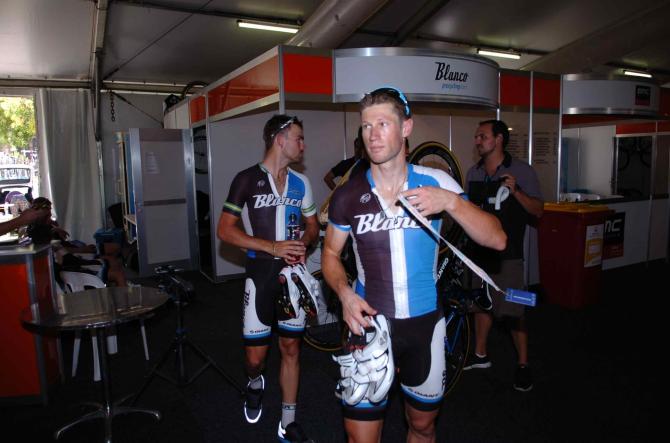Renshaw continues conversion to sprint role
Australian on the differences between leading out and sprinting

Mark Renshaw (Blanco Pro Cycling) begins his season in earnest at the Tour Down Under and the Australian will be hoping that he can travel further along the road of conversion between lead-out man and sprinter than he did in 2012.
After three years piloting Mark Cavendish at Highroad, Renshaw opted to explore his own possibilities as a sprinter by joining Rabobank (now Blanco) ahead of last season. The campaign yielded just one victory, a stage at the Tour of Turkey, and while sharing sprinting duties with Theo Bos was undoubtedly a mitigating factor, Renshaw admitted that he was disappointed with his return.
“I’d hoped for a better season,” Renshaw told Cyclingnews. “I had some good form but results are what matters and I didn’t live up to my expectations during the year for a number of reasons.”
Renshaw imagined beforehand that the psychological – as opposed to the physical – aspects of making the transition from lead-out to sprinter would prove the greatest obstacle. That concern was misplaced, while the technical nuts and bolts of putting together a lead-out train also entered the equation.
“I thought the mental aspect would be quite big so I worked a lot on that side of things but it’s actually the physical aspects and teamwork that makes the difference,” he said. “Mentally I could handle it, but it was just that in some races I needed to be in better position and I needed more help. Ultimately it came down to what happened on the road and not so much the mental side of things.”
As the season began, Renshaw became increasingly versed in the differences between being a lead-out man and sprinter, quickly realising that it was “like chalk and cheese.” The crucial difference, he noted, is that while a lead-out man can make a series of smaller efforts throughout the day and still perform in the final kilometre, a sprinter cannot afford to be caught out of position at any point during the day.
“As a lead-out man, you’re expected to drop your leader off at 200 metres to go but there are a lot of instances during the race where you have to move him up too,” he said. “But it’s feasible to use that energy and still do your job in the final kilometre while as a sprinter, if you’re missing 10 percent, you just won’t make it.”
Get The Leadout Newsletter
The latest race content, interviews, features, reviews and expert buying guides, direct to your inbox!
Not that Renshaw ignored the need to make some physical adjustments in order to compete full-time as a sprinter. A training regimen that had previously been largely devoted to the honing the steadier sprint cadences of the lead-out man was tweaked to work on shorter, more powerful efforts.
“I changed a lot of my training at the start of 2012 to be more explosive. I gained more watts so it did help and I probably didn’t work on the long, 30-second sprint efforts as much as I did before. It worked and I could feel the results, but it still comes back to positioning: if you don’t have a good position, then it doesn’t really matter what you do.”
Bos
In spite of his new departure as a sprinter in 2012, however, Renshaw still found himself pressed into duty as a lead-out man for Theo Bos on several occasions. “That took away a lot of chances for me but he won a lot so the team was happy,” he said diplomatically.
But was Renshaw happy?
“Well, I’d like to win more races, that’s obvious, but the objective is for the team to win and I’m a team player,” he said. “And in saying that, I still had my opportunities, like at Paris-Brussels, where Theo helped me and I was second. That comes down to my physical abilities and I made an error and didn’t win. It’s not that I didn’t get chances, it’s that I missed the chances that I did have, whereas Theo hit the bullseye every time.”
While the nature of the personalities involved mean that the Renshaw-Bos pairing seems highly unlikely to spark the kind of tensions that defined the Cavendish-Greipel dynamic at Highroad, Blanco’s two sprinters will follow largely separate programmes in 2013.
“I think we’ll probably race less together now because we have more back-up for both trains,” he said. There are probably two or three races where I’ll team up with Theo, but a lot of the time we’ll have separate objectives.”
Even when the two fastmen are asked to perform together, however, Renshaw does not envisage any creative differences upsetting the rhythm of the Blanco lead-out train. Indeed, the very idea seems anathema to the quietly-spoken Bathurst native.
“I’m too much of a team player to have that happen and ultimately I know that I’m probably a better lead-out man than I am a sprinter, the past has proven that,” he said. “I made the move to Rabobank to improve as a sprinter and try to win races, but it’s only natural that the team would want me to help Theo too.”

Barry Ryan was Head of Features at Cyclingnews. He has covered professional cycling since 2010, reporting from the Tour de France, Giro d’Italia and events from Argentina to Japan. His writing has appeared in The Independent, Procycling and Cycling Plus. He is the author of The Ascent: Sean Kelly, Stephen Roche and the Rise of Irish Cycling’s Golden Generation, published by Gill Books.